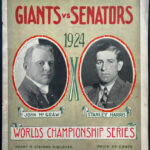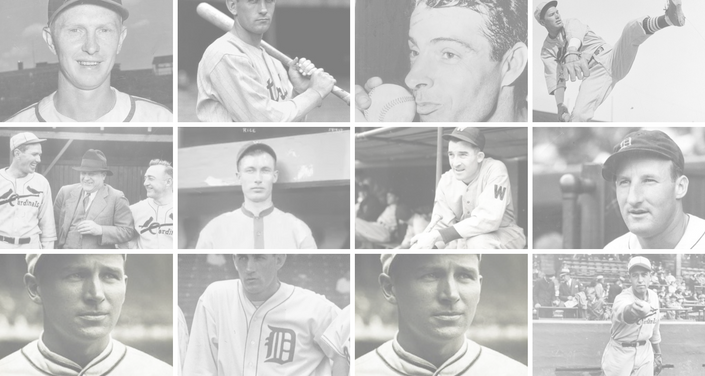Joe McCarthy’s 1937 Yankees fell short of the 1936 club’s exploits in a couple areas. AL champions by 19 1/2 games in ’36, the Yanks had to settle for a mere 13-game margin in ’37. And whereas the Yanks boasted five 100-RBIs men in ’36 — Lou Gehrig, Joe DiMaggio, Tony Lazzeri, Bill Dickey and George Selkirk — they had only three in ’37. But what numbers those three put up. DiMaggio drove in 167 runs, Gehrig 159 and Dickey 133 — an amazing total of 459.
The Yankees had the horses, all right. And you could start with the Iron Horse, Gehrig, who enjoyed his last magnificent season before amyotrophic lateral sclerosis began to take its toll on his career and, all too soon, his life. Gehrig batted .351 and walloped 37 home runs. DiMaggio hit .346 with 46 homers, and Dickey finished at .332 and smacked 29 homers. Selkirk produced at a frantic pace — 18 homers and 68 RBIs in just 78 games — that would have placed him in the DiMaggio-Gehrig-Dickey stratosphere but missed half the season because of injuries.
Beyond their big boppers, the Yankees also had the American League’s only 20-game winners in Lefty Gomez (21-11) and Red Ruffing (20-7) and a standout relief pitcher in Johnny Murphy, who recorded 12 victories while coming out of the bullpen and 13 overall.
Bill Terry’s National League-winning Giants boasted two 20-game winners, but Terry’s club lacked the thump of the Yankees. Carl Hubbell (22-8) reached 20 victories for the fifth consecutive season, and rookie Cliff Melton (20-9) burst upon the scene. But only Mel Ott provided Yankee-type power with 31 homers and 95 RBIs.
Hubbell and the Giants were coasting with a 1-0 lead over the vaunted Yanks entering the bottom of the sixth of Game 1 of the ’37 Series. Before the inning was over, though, the Yankees had struck for seven runs. DiMaggio and Selkirk each poked bases-loaded singles and notoriously poor hitter Gomez drew two walks. The Yanks, who got a bases-empty home run from Lazzeri in the eighth and six-hit pitching from Gomez, won 8-1.
The next day Melton and the Giants led 1-0 in the last of the fifth. This time, the Yankees struck for two runs — the second scoring on pitcher Ruffing’s single. Ruffing then drilled a two-run double in the American Leaguers’ four-run sixth, and the Yankees were on their way to a second consecutive 8-1 victory. Ruffing yielded seven hits and, besides benefiting from his own batting prowess, received three RBIs offensive support from Selkirk.
The Yankees continued on their merry way in Game 3 as Monte Pearson, getting last-out relief help from Murphy in the ninth inning after the Giants had loaded the bases, won.
The big inning, so much a Yankees trademark, came into play again in Game 4 as the Yanks went for their fourth sweep in their last five World Series appearances. In a turnabout-is-fair-play scenario, though, it was Terry’s team that set off the offensive fireworks that resulted in six second-inning runs. Center fielder Hank Leiber got things going with a base hit and then capped the outburst with a two-run single. With Hubbell capably handling the Giants’ pitching chores that afternoon, the NL champions were in good shape. At least for one day. The Giants went on to record a 7-3 victory as Hubbell threw a six-hitter. In the ninth, the last inning he ever pitched in World Series competition, Hubbell allowed a home run to Gehrig. The one-out drive proved to be Gehrig’s last Series homer.
In Game 5, Myril Hoag whacked a second-inning homer for the Yanks and DiMaggio connected in the top of the third, but Ott got the runs back for the Giants with a two-run shot in the last of the third. Then, in the fifth, Lazzeri hit a leadoff triple and scored on Gomez’s single off the glove of Giants second baseman Burgess Whitehead. Two outs later, Gehrig doubled home Gomez. It was 4-2 Yankees, and that’s the way the game and World Series ended as Gomez pushed his Series record to 5-0.
The powerful New York Yankees were World Series titleists for a record sixth time, breaking the mark they had shared with the Philadelphia Athletics.
That the Yankees were hardly pressed in this Series despite batting only .249 wasn’t exactly reassuring to the National League, whose member teams must have wondered what fate might possibly await them if the Yanks were playing at peak efficiency. The senior league’s worst fears soon were realized: Its next two World Series representatives found the going even more difficult against McCarthy’s athletes. Yes, even tougher than the four-games-to-one humiliation that the New York Giants were forced to endure in 1937.




